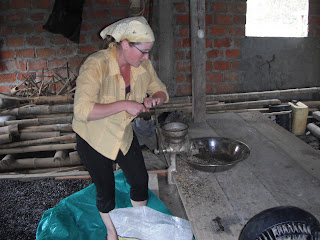Yesterday afternoon I made the mistake of having a tiny amount of Hazelnut coffee mixed with decaf coffee at a meeting, which resulted in two things: 1. Me still being energized and unable to sleep at a reasonable hour (I'm normally high-energy enough without any caffeine), and 2. Reminded me of helping to process coffee in Ecuador. From picking, to milling, to roasting, to grinding again, it is a very labor intensive process.
First, the ripe fruit, or cherry (so called because of the bright red color), are removed from the coffee plants by hand.
Me picking coffee at Don Ernesto's farm
The coffee is then allowed to dry by being spread out on level surfaces and moved around periodically (in Hawaii I saw this part done in a very large area with retractable roofs for covering in case of bad weather). Then, after the cherries are dry, the outside of the fruit needs to be separated from the green coffee beans. This is done here by hand with a mill. A very good arm workout can be had by processing the coffee this way.
Milling the coffee that was already dried (you can see some in the background) to remove the bean from the fruit
Running the cherries through the mill helps to remove the outer coating, but it then needs to be separated from the beans before roasting. Here, this was accomplished with a fan, positioned over a bowl, where the beans were lifted by hand and the outer, dry shell, was blown off (the big pile of dry coating can be seen in the foreground).
Wuilter and Paco using a fan to remove the dry skin from the bean before roasting
With the bean finally separated from the rest, careful roasting over an open fire is the next step in the processing. This part is really an art form, as you don't want to burn the beans.
Betsy roasting coffee that has already been dried
Coffee in the beginning stage of being roasted over the fire
After roasting, the coffee can again be ground by hand for roasting, or kept as whole-bean for sale to individuals.
Have a question or comment? Please feel free to post below, or send me an email!





No comments:
Post a Comment